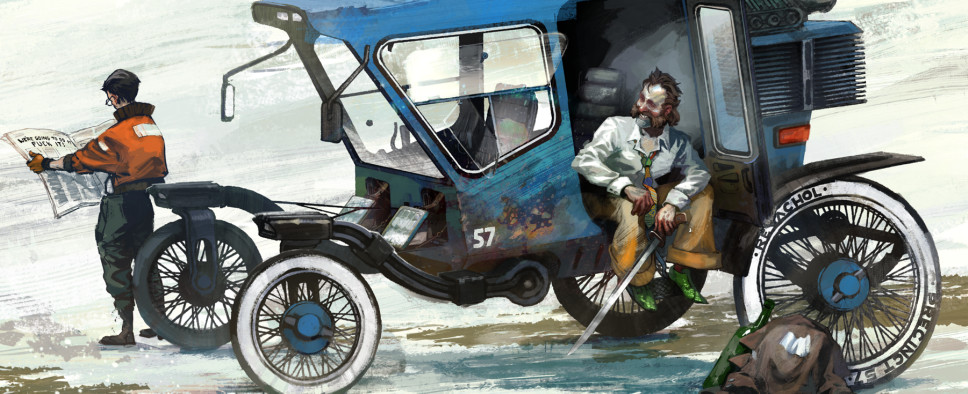No Truce With the Furies Preview
-
Category: News ArchiveHits: 1672

No Truce With the Furies is an upcoming police-procedural RPG with an incredibly intriguing role-playing system. So far, most of what we know about the game came from the official developer blog. The folks at RPG Codex decided to remedy this and have actually sent a man to Tallin, Estonia, where the developers live and work, for an exclusive hands-on preview. Thanks, RPG Codex, for that.
The preview is nothing short of glowing, filled with excitement for the project, photos from the studio, and a bunch of screenshots and pieces of concept art. Check out this excerpt for yourself:
I got to play a half-hour or so of an early pre-alpha build, and while the road ahead is long and hard, this is not just a pipe dream, a pitch, or a tech demo. This is already a game. Moment-to-moment gameplay is fluid, natural, and polished; some scripting lacunae and missing puddle reflections aside, it looked, sounded, and played better and glitched out less than, say, Pillars of Eternity in its first beta build. It looks achingly beautiful, with a tree casting a shadow on a flaking plaster wall, raindrops spotting and darkening the pavement as the weather changes, ice floes undulating on a congealing sea, bringing to life a pastel-toned painting of beautiful decay, rich with texture, form, light, and depth. Ambient sound is already in, and there were snatches of the soundtrack composed and performed for the game by the UK group British Sea Power, ready to out-rock, out-karaoke, and out-disco anyone out there.
Other British musicians are involved as well. SikTh vocalist Mikee Goodman gave the protagonist’s reptilian brain a snarling, grating cockney voice in what has to be one the strongest intros to any RPG since Planescape: Torment (that, by the way, unlike the description of ZA/UM’s ambition above, is my take, not Kurvitz’s). There are no lore-dumps or long-winded expositions here, just pain, loss, and a rude awakening into a dead serious police procedural that has you looking for a song and a mysteriously missing shoe, and then: doing something about the corpse hanging in the tree in the backyard for the last week or so.
The core gameplay in No Truce is a hybrid of point-and-click adventure and RPG dialogue. There is no pixel-hunting; all interactable objects light up with the tab key, and observations brought up by successful (passive) skill checks show up as little thought bubbles you can click on. However, all interactions more complex than a single-line tooltip happen through the dialogue interface, dubbed the Feld Playback Experiment, itself an in-world mystery. Underneath ticks away a robust and parsimonious system of RPG mechanics: what appears in the dialogue interface is a product of your stats, your skills, your thought inventory, your history tracked in behind-the-scenes counters, and die rolls – subtly but effectively represented by a brief sound effect and animation of a spooling tape. Some checks are passive: a line appears in the Feld if you succeeded in an invisible stat check – for example, a successful Empathy check will have that part of your mind inform you that your interlocutor seems to have a thing going with the person they’re talking about; pass an Esprit de Corps check when you do something particularly stupid, and your partner will have your back. Others are active: you make the roll when picking the choice, with the odds displayed in a tooltip.
A great many of these checks, interactions, and dialogues happen inside your mind. Your skills and stats are talking to you, pointing out things, suggesting things to say, demanding things, making connections, causing thoughts to appear in your thought cabinet. Your reactions to these prompts will determine what kind of cop you will become: behind the scenes, counters are incremented and flags are set. There is a tremendous amount of reactivity to these stats, counters, and flags everywhere: an ashtray may spark a craving for cigarettes or do nothing at all; a successful Visual Calculus check will light up a detail in the crime scene that a less observant cop would have missed. The dialogue tree is a virtual forest, a thicket of nodes with associated thresholds and conditions, changing as you change.
There are two kinds of active checks: white ones you can return to after leveling up a skill, while you only get a single shot at a red one. The twist with those red checks is that the failures are often even more rewarding than the successes, not mechanically or in terms of achieving your aims, but in story and character. My failed checks had me in stitches: a hilariously awkward line, netting me a helpless laugh mixed with pity and a dash of sympathy, or another, which becomes a running joke. Kurvitz isn’t kidding about the “disgrace to the uniform” and “complete failure” thing. That’s what you are, or start out as. It’s up to you and your choices whether, over your adventures in the bad part of the bad part of town, you manage to climb out of it, or fade into the pale as another anonymous hobo, by way of Hobocop. Yes, you can equip a plastic bag to collect beer cans you can turn in for a few pennies in a last-ditch effort to stave off despair and defeat.

